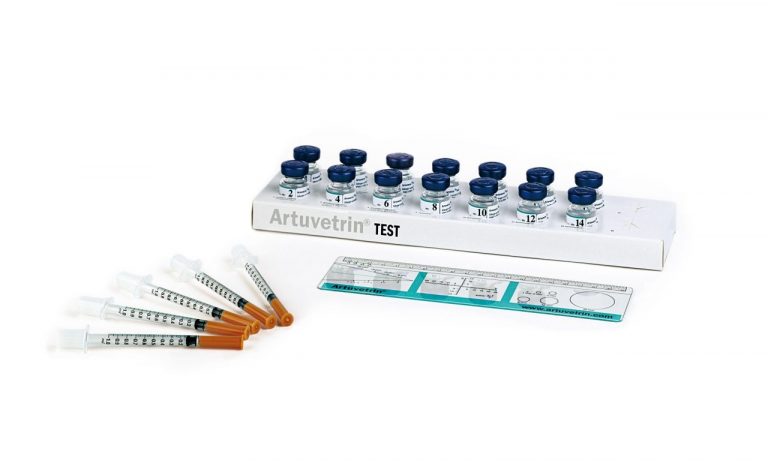Artuvetrin® Skin Test
Key facts about Artuvetrin® Skin Test
Preferred by dermatologists- 80 individual allergens or mixtures available
- Supplied in 3-ml vials (sufficient for 60 tests)
- Shelf-life of 6 months
- Supplied within 8 working days
- Concentrations based on determined threshold values for reliable results

Basic Skin Test Set
The perfect starting pointWith over 80 individual allergens and mixtures available, veterinarians can compose their own set of tests. We also provide a Basic Skin Test Set that includes the most important allergens:
Negative control – Positive control – Grass pollen mix – Tree pollen mix 1 – Tree pollen mix 2 – Weed pollen mix – Copra mite – Farinae mite – Hay mite – House-dust mite – Grain mite – Cat epithelium – Fungal mix

How to perform a skin test
The skin test is carried out on the lateral thorax of the patient after carefully shaving a patch of hair. A small quantity (0.05 ml) of histamine and saline (positive and negative controls) plus solutions of the chosen allergens are injected into the skin at different locations. After 15–20 minutes, all injection sites are assessed for skin swelling (wheal formation). If there is allergy to a certain substance, an inflammatory reaction will appear on the skin, visible as a swelling. The extent of this swelling is compared to that of the positive and negative controls, allowing identification of the substances to which the patient is allergic. A single patient may be allergic to many substances.
Steps of skin-testing
- Carefully shave a patch of hair on the lateral thorax wall. The test can only be carried out on intact skin.
- Number the injection sites on the skin using a marker or pen at intervals of 2.5 cm.
- Fill the syringes with the different allergens and control solutions. The numbers on the vials should correspond to the numbers on the skin.
- Administer 0.05 ml of each allergen and the control solutions subcutaneously. A small bubble will appear after injection.
- Read the skin reaction after 15–20 minutes by noting any increase in the size of the wheal with a marker or pen.
Interpretation of the skin test
The skin reactions are measured after 15–20 minutes, and any increase in the size of the wheal is measured using a ruler. The response to the negative control is generally 0 mm.
Skin-wheal diameters measuring more than half the wheal diameter of the positive control are considered to be positive results. (That is, half the diameter of the positive wheal minus that of the negative wheal.) When evaluating positive reactions, the size and configuration of each wheal is important, but it also important to verify whether the specific allergen is of relevance in the patient history.
The expiry is determined by the stability of each specific allergen. Specific expiration dates are stated on each label.
The skin test is, in principle, not painful, therefore analgesics (anaesthetics) are not needed. Sedation is enough, but the type of sedative must be chosen carefully.
Those that do not affect the results are:¹
- Xylazinehydrochloride (including Sedazine)
- Medetomidine (including Domitor)
- Tiletamine hydrochloride/zolazepam hydrochloride (including Zoletil)
- Halothane
- Isoflurane
Those that do affect the results are:
- Xylazinehydrochloride/ketamine hydrochloride
- Ketamine hydrochloride (including Keta-ject)
- Diazepam
- Acepromaxinemaleate (Neurotranq)
- Propofol
¹The ACVD Task Force on Canine Atopic Dermatitis (XVII): Intradermal testing. Vet Immun Immunopath 81 (2001) 289–304.
If a negative control is more than 0 mm, it must be compensated for using the following formula:
(Negative control + positive control) / 2
For example:
- Negative control: 6 mm
- Positive control: 14 mm
- (6 mm + 14 mm) / 2 = 10 mm
All results equal or above 10 mm are positive.
As far as we know, the following medication can be administered to dogs or cats without affecting the results:
- Oclacitinib
- Lokivetmab
- Antibiotics
- Anti-fungal agents
- Heartworm drugs
- Anti-flea agents and devices
- Thyroid medications
- Heart medications
- NSAIDs
This means that the use of the above medications can be continued as normal.
In cats, the pathogenesis of skin problems due to undesirable reactions to allergens in the environment is largely unknown. Therefore, the reliability of the skin test in cats is unclear. The use of immunotherapy in cats is associated with significant improvements in clinical signs (60–70% of cats see improvement)¹. These findings are supported by the experience of some vets using immunotherapy in cats.
¹Efficacy of hyposensitisation in feline allergic diseases based upon the results of in vitro testing for allergen-specific immunoglobulin E. J Amer Animal Hosp Assoc 33(3), 282–288.